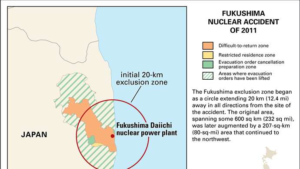In News: Recently, Japan’s government approved a plan to release more than one million tonnes of treated water from the stricken Fukushima nuclear plant into the ocean, in a controversial decision that follows years of debate.
About Fukushima Nuclear Accident
- Fukushima Daiichi nuclear accident, an accident in 2011 at the Fukushima Daiichi plant in northern Japan, the second worst nuclear accident in the history of nuclear power generation.
- The site is on Japan’s Pacific coast, in northeastern Fukushima prefecture about 100 km south of Sendai.
- The facility, operated by the Tokyo Electric and Power Company (TEPCO), was made up of six boiling-water reactors constructed between 1971 and 1979. At the time of the accident, only reactors 1–3 were operational.
- Tsunami waves generated by the main shock of the Japan earthquake on March 11, 2011, damaged the backup generators at the Fukushima Daiichi plant.
- Explosions resulting from the buildup of pressurized hydrogen gas occurred in the outer containment buildings enclosing reactors 1 and 3 on March 12 and March 14, respectively. A third explosion occurred on March 15 in the building surrounding reactor 2.
- The explosion, along with a fire touched off by rising temperatures in spent fuel rods stored in reactor 4, led to the release of higher levels of radiation from the plant.
- In the days that followed, some 47,000 residents left their homes, many people in areas adjacent to the 20-km evacuation warning zone.
- Nuclear regulators elevated the severity level of the nuclear emergency from 5 to 7—the highest level on the scale created by the International Atomic Energy Agency—placing it in the same category as the Chernobyl accident, which had occurred in the Soviet Union in 1986.

















